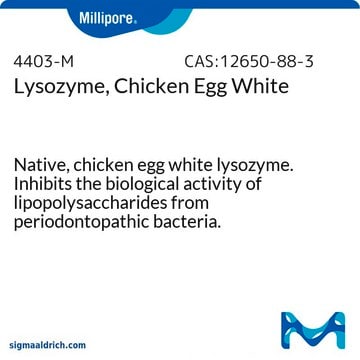This product is supplied by the ATCC. The growth phase at the time of harvest is not reported by the supplier. In general, in order to maximize production and viability, cells are in log phase or beginning stationary phase at the time of harvest.
M3770
Micrococcus lysodeikticus ATCC No. 4698
suitable for substrate for the assay of lysozyme, lyophilized cells
Synonyme(s) :
Micrococcus luetus
Sélectionner une taille de conditionnement
97.80 CHF
Date d'expédition estimée le30 mai 2025
Sélectionner une taille de conditionnement
About This Item
97.80 CHF
Date d'expédition estimée le30 mai 2025
Produits recommandés
Forme
lyophilized cells
Niveau de qualité
Adéquation
suitable for substrate for the assay of lysozyme
Température de stockage
−20°C
Application
Actions biochimiques/physiologiques
Qualité
Définition de l'unité
Code de la classe de stockage
11 - Combustible Solids
Classe de danger pour l'eau (WGK)
WGK 3
Point d'éclair (°F)
Not applicable
Point d'éclair (°C)
Not applicable
Équipement de protection individuelle
Eyeshields, Gloves, type N95 (US)
Faites votre choix parmi les versions les plus récentes :
Certificats d'analyse (COA)
Vous ne trouvez pas la bonne version ?
Si vous avez besoin d'une version particulière, vous pouvez rechercher un certificat spécifique par le numéro de lot.
Déjà en possession de ce produit ?
Retrouvez la documentation relative aux produits que vous avez récemment achetés dans la Bibliothèque de documents.
Les clients ont également consulté
Protocoles
To measure achromopeptidase activity, this procedure uses bacterial cells and a turbidimetric rate assay. Turbidity is measured at 600 nm using a spectrophotometer.
This enzymatic rate determination may be used for Lysozyme products. It is not to be used to assay recombinant or insoluble Lysozyme on agarose.
-
From which growth phase are the bacteria harvested?
1 answer-
Helpful?
-
Active Filters
Notre équipe de scientifiques dispose d'une expérience dans tous les secteurs de la recherche, notamment en sciences de la vie, science des matériaux, synthèse chimique, chromatographie, analyse et dans de nombreux autres domaines..
Contacter notre Service technique







